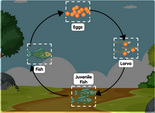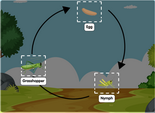Life Cycle of an Alligator, Science Game for Kids
How many young alligators can be born at once? They live in different places. This science game for children teaches you about the life cycle and habits of alligators. Alligators are reptiles that have a fascinating life cycle. Crocodilians are also a part of their family.
Discovering the Intriguing Life of an Alligator: From Hatchling to Mighty Predator
Alligators, with their fearsome appearance and prehistoric lineage, are among the most captivating creatures on Earth. But beyond the immediate fascination they draw, there's a compelling story: the life cycle of an alligator. Dive into this incredible journey of growth, survival, and adaptation as we explore the lifespan of an alligator.
Hatchling: The Beginning of the Journey
Every alligator's life starts in an egg. After about 65 days of incubation, a tiny alligator with a soft body and an egg tooth (used to break the shell) emerges. These hatchlings, although vulnerable, are not entirely defenseless. Their mother guards them fiercely, ready to protect them from any predator.
Juvenile Stage: Growing Up in the Wild
As the months go by, the hatchling grows and enters the juvenile stage. Their body starts hardening, providing more protection. During this time, which can last several years, young alligators remain in groups called 'pods.' This communal living offers safety in numbers, a critical aspect for survival in the wild.
Adolescence to Adulthood: The Rise of the Apex Predator
Once the alligator reaches about 6 feet in length, it enters its adolescent phase. This is a crucial period as the alligator lifespan sees rapid growth and increased independence. Their diet expands to include larger prey. By the time they transition into adulthood, alligators have established themselves as apex predators, ruling their freshwater habitats.
The Remarkable Lifespan of an Alligator
On average, wild alligators live for about 35 to 50 years. However, in captivity, where they're safe from threats and receive regular meals, the lifespan of an alligator can stretch to 65-80 years! It's a testament to their robust nature and adaptability.
Beyond Survival: Breeding and Legacy
A significant part of the life of an alligator revolves around reproduction. Mature females, usually above ten years of age, build nests and lay eggs annually. Their maternal instincts are strong; they guard the nest ferociously and even gently carry the hatchlings in their jaws to water once they emerge.
Engaging Kids with the Alligator Life Cycle
For those eager to dive deeper into the fascinating world of alligators, this interactive science game for kids is a must-visit. It offers a fun and informative look into the life cycle of an alligator, ensuring kids learn while they play. And for a broader exploration of various scientific topics, ESL Games Plus Science Games is an invaluable resource.
Conclusion
The alligator, with its ancient lineage and incredible adaptability, stands as a testament to nature's wonders. Understanding the life cycle of an alligator gives us a deeper appreciation for these magnificent creatures and the ecosystems they inhabit. Through interactive learning and hands-on exploration, the next generation can foster a love and respect for these age-old predators.
In the early summer, alligators lay eggs.
Helpful facts about alligators
The alligators choose a place rich in vegetation, leaves, and water and then use their tails to gather the materials needed to build a nest. The nest is typically located between three to five meters from water's edge. The eggs are heavily calcified and undergo crystal dissolution. The eggshell is weakened by acidic metabolic byproducts from the nest bacteria, which facilitates hatching.
Typically, alligators lay their eggs in June and July. During incubation, mother alligators cover eggs with their skins. To let the eggs know when they are ready for hatching, the female alligator communicates directly with them. Alligators hatch as fully-carnivores, and eat small aquatic animals. For the first year, the young are with their mother. The young spawned from other nests are called a pod. They will remain with their mother for at most one year.
A juvenile alligator is an animal that is less than six years old and approximately 1.8 meters in length. Males grow faster than females. Males and females both reach sexual maturity around seven to eight feet. However, females tend to be larger than the males. Louisiana alligators grow at an average of 30 cm per annum during their first six years. Captive alligators can grow up to 150 cm per year, which is faster than their wild counterparts.
Both male and female alligators look for partners in the spring. Once they have found the right partner, alligators exchange pheromones in order to attract a mate. The female will lay eggs once she has found her mate. The United States has a single breeding season, which runs from April through June. The mother can protect the baby for up to one year during this period.
A crocodile lives for about 70 years while an alligator can live for about 30 to 50 years. They begin their lives as eggs on a swampy shore, and reach sexual maturity at six feet. The females reach sexual maturity at six feet and then begin to reproduce. After one year of development, the female will conceive between 10 and 70 eggs and the cycle will start all over again.
An alligator hatchling will be smaller and lighter than an adult during its first year of development. The American alligator hatchlings are also spotted. The first year of alligator hatchlings is filled with predators. As such, most will not survive to adulthood. The male alligator can become sexually mature around the age of 10 years, but the female is not capable until she reaches six foot.











